1st Position Blues Harp – An Introduction (Part 2)
A guide to straight blues harping
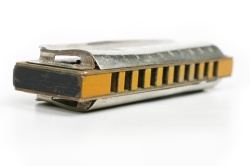
In Part 1 we looked at an overview of first position. We considered why it may be something blues players put off till later. We noted that 1st position blues mainly comprises deep low end draw bends and confident high end blow bends, and that the middle octave has little to offer to those who cannot overbend.
We also recommended that blues players develop the ability to identify positional playing by ear. This isn’t as hard as you might believe. It’s like birdsong. You could probably recognise the call of an owl, a seagull or a finch right? Well the three principal blues harp positions also have their own signatures.
In this, the second part of our series, we look at the bottom end blues scale in 1st position and its trade licks. Meantime here’s more of our series theme tune from Nine Below Zero. The song is called Doghouse and it’s from their second album, Don’t Point Your Finger. It’s played in first position using a B harp and, for information, the opening top-end lick is 10B 10B’ 9B 9B’ 8B 7B .
1st position low end blues scale
Fluency in the blues scale provides a firm foundation for your repertoire of blues licks. So let’s get back to basics for a moment.
Grab a D harp and play the 2nd position blues scale 2D 3D’ 4B 4D’ 4D 5D 6B. It gives the key of A major. Now switch to an A harp and locate these same notes between holes 1B and 4B.
If you can draw bend, you’ll find most of it’s there. But you’ll also notice something is missing. That partially bent blues note in 3D’ on the D harp (the flattened third) is absent on the A harp. You won’t find it without a radical overblow in 1B#. You can play 2B on the D harp, but not 2B’.
Let’s look at it the other way. The 2B on the A harp is equivalent to a clean 3D on the D harp, albeit an octave lower. You will get away with it, but it can sound polite in isolation. We like to think of 2B in 1st position as the blues wannabe note. It almost got there, but didn’t quite make it. But it turns out this is a good thing. The clean 2B has become the hallmark of all those low end signature riffs in 1st position blues. It’s this that generates a lot of the melancholic mood. Just try this lick
4B 3D 2D 2D”..2B 2D”..2B..1B
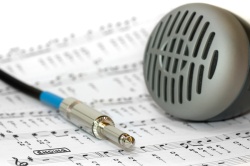 Just in case you were wondering
Just in case you were wondering
While 2D and 3B both provide the same note on a diatonic harp and 2D is part of our 1st position blues scale, when it comes to playing 1st position licks, 3B is seldom used. For practical purposes we focus on 2D because 3B just makes things awkward. Trust us on this point for now. It will all become apparent when we look at some low end licks.
Mapping it all out
Here is the 1st position blues scale tab. The sound clip is played on an A major harp.
1B 2B 2D” 2D’ 2D 3D’ 4B
4B 3D’ 2D 2D’ 2D” 2B 1B
Now let’s look at a graphic of what’s going on. Click the image below to enlarge it or print yourself a copy here. All the safe notes have been highlighted in red. That blues wannabe note in 2B has also been highlighted in mauve, together with the overblow in 1D#.
The 5B an octave up from 2B has also been highlighted (the blues wannabe’s kid brother), along with the overblow notes in 4B#, 5B# and 6B# that complete the blues scale in the mid octave range. 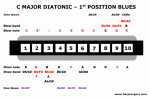
8B has not been coloured in the upper octave because we have a complete blues scale here. Our flattened third is readily available as a blow bend in 8B’. More of this in part three.
Low end signature riffs
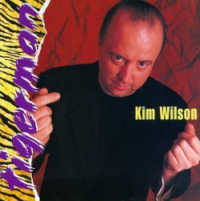 Now we’ve nailed the scale, let’s look at some low end signature licks together. We’ll start with Kim Wilson’s version of Trust My Baby (by Sonny Boy II). It’s on his Tiger Man album. Grab a G major harp and let’s get cooking.
Now we’ve nailed the scale, let’s look at some low end signature licks together. We’ll start with Kim Wilson’s version of Trust My Baby (by Sonny Boy II). It’s on his Tiger Man album. Grab a G major harp and let’s get cooking.
3D 4B 2D” 2D
2D”..2B 1B………
2D”..2D 2D…
See what we mean by hitting 2D rather than 3B? It would become messy and you’d lose the soulfulness generated by raising 2D” through 2D’ and into 2D. Once you’ve cracked the phrasing for this lick, experiment with tongue blocking, tonal variety, hand wah-wah and throat vibrato to complete the delivery. This is low down, deep and mournful stuff.
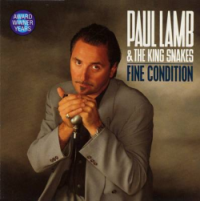 I cry ‘nobody loves me and nobody seems to care!’
I cry ‘nobody loves me and nobody seems to care!’
Now we’ve mapped out the principal 1st position blues notes and a classic lick in the lower octave. You’ll find countless variations on this lick in other blues songs. Next let’s check out the opening to BB King’s Every Day I Have The Blues, recorded on this occasion by Paul Lamb & The Kingsnakes on their 1995 album Fine Condition.
This example shows us how notes from the same blues scale in the lower 1st position register can deliver a lead riff and accompaniment. You’ll need an A major harp.
Riff 1
2D”..2B 1B-4B 1B-4B Octaves!
2D”..2B 1D-4D 1D-4D Reverse the 1-4 hole direction over the V chord
Riff 2
2D”..2D 3D
2D”..2D 3D
2D”..2D 4B …..9B’-9B
Riff 3
2D”..2B 4B 4B Lends weight to the vocal line
2D”..2B 4D 4D Reverse the 4 hole direction once over the V chord
Interestingly, when it comes to the harmonica solo in this particular number, Paul Lamb switches to second position on a D major harp. He might have taken the more obvious route of staying with the A harp and hitting the upper octave, however switching harps mid song is a legitimate option and can be very effective. It’s not necessarily cheating! Go see Charlie Musselwhite and you’ll find he does this regularly. Little Walter often did it as well.
I’m a home run hitter baby, and I can hit ’em all night long!
One of the finest examples of 1st position playing listened to at the Harp Surgery is the title track of Jerry Portnoy’s Home Run Hitter album. He uses an A major diatonic. Here’s the intro.
..4D..4D 4D..4D..4D 4D..3D..2D 2D”..2B rpt x 4
2D 2D”..2D 2D 2D”..2B..1B rpt x 2
4B 3D 2D
2D”..2B
4B 4B..3D 2D
Once again it works around that familiar 1st position blues pattern in the lower octave, but Jerry uses some highly imaginative phrasing. Now listen to the clip again and note what happens over the V chord. It’s brief. Jerry breaks into a 4D-5D trill. Here’s a clip of the part we’re referring to, followed by the remainder of the intro and a fade out.
3D ..4B
4D’..4D~5D trill
2D..3D 4B..4B 3D..2D
2D..2B..1B
..4D..4D 4D..4D..4D 4D..3D..2D 2D”..2B
..4D..4D 4D..4D..4D 4D..3D..2D
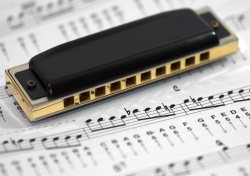 One and one makes two
One and one makes two
You may not have noticed, but cross harp notes are being used over the V chord. Let’s spend a moment figuring this out; it’s an important concept not only in 1st position, but in others too.
Taking an A major harp in 1st position, we know that we start playing over the A major chord. It’s straight harp after all. This is the I chord or tonic. We then move to the IV chord or sub-dominant which is D major. But typically we’re digging into the same deep bending territory as the I chord. More of this shortly. However, when we move to the V chord or dominant, we’re playing over E major.
What do we know about E major on an A harp? That’s right. It’s cross harp or 2nd position. So for a brief period in straight blues harping, we can drop in 2nd position licks over the V chord because the two positions coincide. (The same is true on the turn-around if it moves back up to the V chord).
Often this takes the form of 3D 4B 4D’..4D~5D trill. But could also try a simple run down 5D 4D..3D..2D and almost any other 2nd position blues lick. How about 2D 3D 4B 4D’..4D 6B 4D..4D’ 4B 3D’ 2D just to be fancy? Big Walter might choose 2D 3D’..3D..4D.
So how do we deal with the IV chord in 1st position?
Let’s take an A harp. For the IV chord we’re looking for notes that fit over D major. Sonny Boy II often did no more than rapidly repeated switch between 3D’ with deep vibrato and 4B. In Hard Hearted Woman, Big Walter finds the D in the full 2D”. He plays 2D”..2D..2D” 2B..1B 4B. But why not experiment? A simple sustained 5D-6D sounds kind of different, but it works.
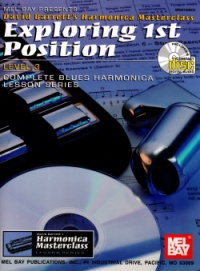 I can’t do my homework any more
I can’t do my homework any more
Check out Dave Barrett’s book on Exploring 1st Position. It has a heap of practice riffs to work through that will develop your bending muscles! Dave also has books which cover 2nd and 3rd position. We also recommend Winslow Yerxa’s book Harmonica For Dummies as a neat way of exploring this feature of the diatonic harp. Check out our Music Store page for both these books.
In part three, we will investigate the top end 1st position blues scale and it’s associated licks. So until then, start working on those blow bends and here’s Mark Feltham with Nine Below Zero to play us out.
Associated posts:
1st Position Blues Harp – An Introduction (Part 1)
1st Position Blues Harp – An Introduction (Part 3)
1st Position Blues Harp – An Introduction (Part 4)



Nice found this. Thank you